Straight vs Curved Axe Handles: Which is Best?

There has been plenty of debate over the years – and a lot of it is overblown, and it mostly comes down to the axe user’s preference. However, there are good reasons to contemplate straight vs curved axe handles for your needs.
Axe handles are curved to improve ergonomics and balance during chopping tasks. Straight axe handles are stronger for tasks like splitting and can be more precise for detailed work when using a carpenter’s axe or hatchet. However, the choice is mostly a matter of preference.
While there is certainly some debate online – to me, it’s pretty clear that each type of handle is better suited for different tasks. And there are reasons the curved handle became so dominant.
Why Most Axe Handles are Curved
There can be two different curves in an axe handle, each with a distinct purpose. They can be used together or on an otherwise straight handle.
Most axe handles have a curve in the grip to account for the natural angle of the user’s wrist and to allow a greater range of motion when chopping or bucking. An axe may also have a forward curve higher on the handle to help balance a blade-heavy axe during horizontal swings.

Most axe handles curve back towards the bottom, and then forward again to form the grip.
The curved grip of an axe is angled about 10°, which compensates for the natural angle of a person’s wrist. This makes it easy and comfortable to align the axe with your forearm during a swing.
This more natural wrist position is easier on your arm for extended work and reduces the chance of injury from over-extending.

This grip also allows the user to choose to extend further to make broader swings and use that additional 10° rotation for chopping on the far side. This is especially useful for bucking logs on the ground.
Important to remember: While these reasons are why the curved grip is beneficial for chopping tasks – It won’t make a difference to an axes performance. It’s about user comfort and preference.
A Curved Handle Can Balance a Heavy Axe Head
A curve in the handle moves the top hand forward closer to the axe’s balance point during a horizontal swing, making it easier to keep the axe level for the majority of the swing.
Most “standard axe handles only have a slight curve higher up, and are often near straight. They can sometimes look more curved than they are because the backside has to flare out to account for the length of the eye.
But the handle can have an exaggerated forward curve, which can help balance heads with large bits (like the Connecticut pattern) while swinging.
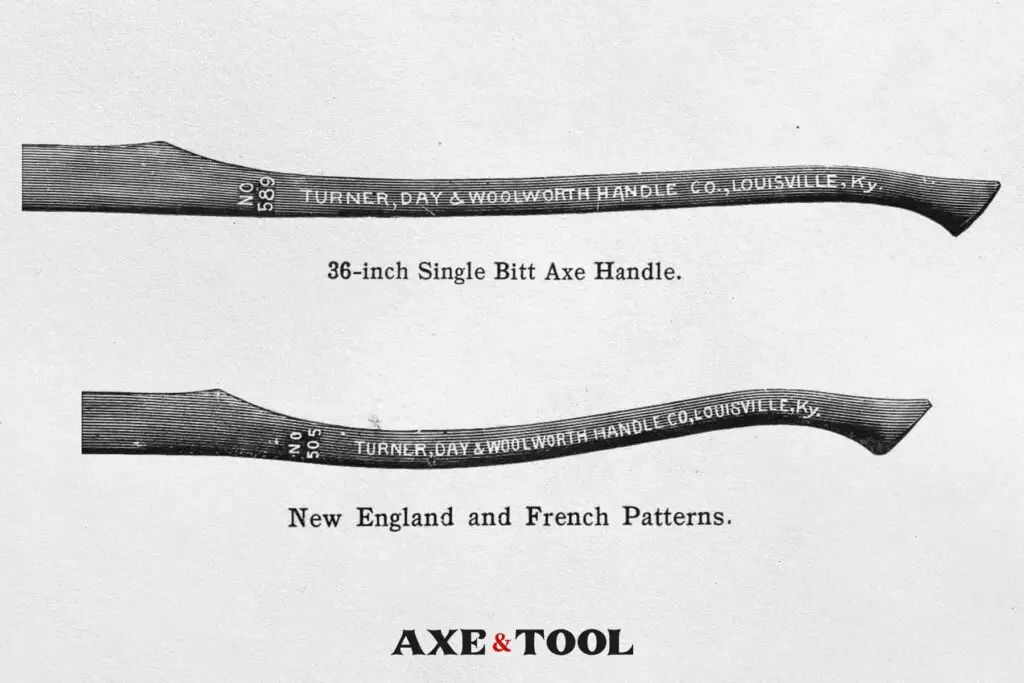
Large axe heads are often heavier on the blade side. The pole (back of the axe) acts as a counterweight, but it’s often not enough to fully balance the axe – So the blade will naturally want to drop down when being swung horizontally.
A blade-heavy axe requires the user to hold tighter, increasing fatigue over time and adding a lot more felt impact vibration with each swing.
When a Straight Axe Handle is Better
While you can absolutely put a straight handle on a felling axe, and many people prefer it – there are some specific uses where they are easily the better choice.
Straight handles are better for splitting and striking tools because the wood is uninterrupted making it stronger, and they rotate less landing flatter on logs. Straight handles are also better for double-sided heads where the axe or tool can be used in either direction.
Splitting Axes Have Straight Handles
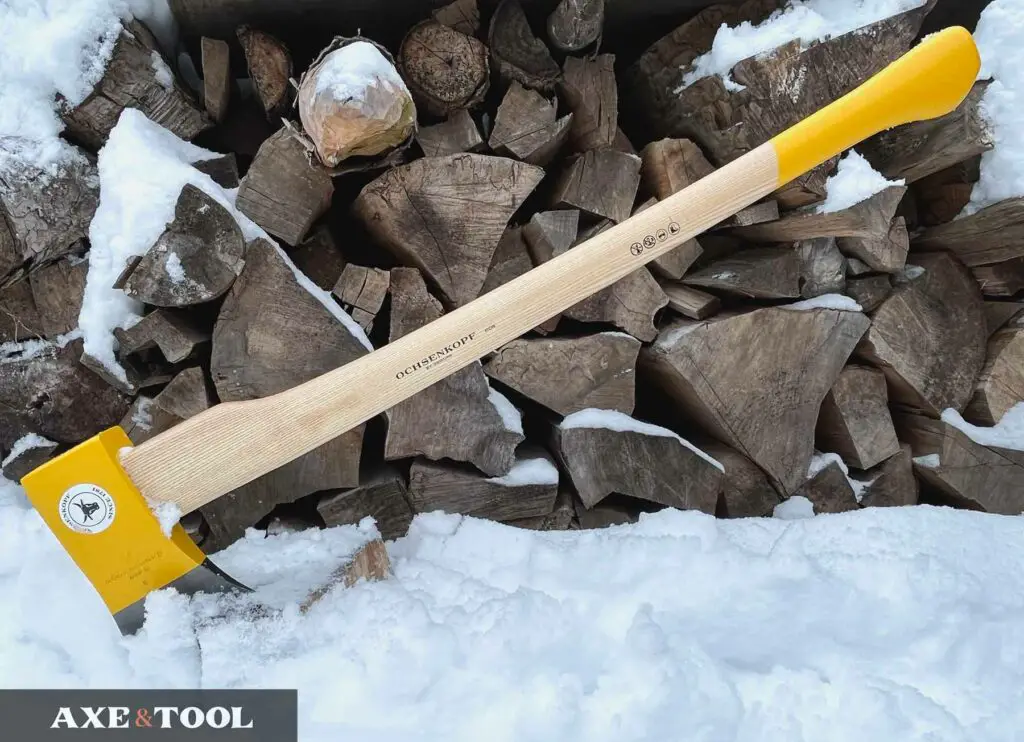
Splitting can be a tough job for an axe handle, it often needs to be used as a lever to pry side-ways and help pop stubborn wood apart – this is where a straight handle is strongest compared to a curved one.
Splitting handles also suffer from “overstrikes” – where the handle hits the wood you are splitting (try and avoid this, but it happens).
Straight Handles are Safer for Splitting
When splitting wood you want less rotation in your axe so it doesn’t swing back towards your feet if it passes through the log. A straight handle makes it easier to consistently land the blade squarely on the log.
You can safely split wood with a curved handle just fine – just be aware of your form and bring the axe down onto the wood, not in an arch (a common mistake).
Hatchets & Carpentry Tools
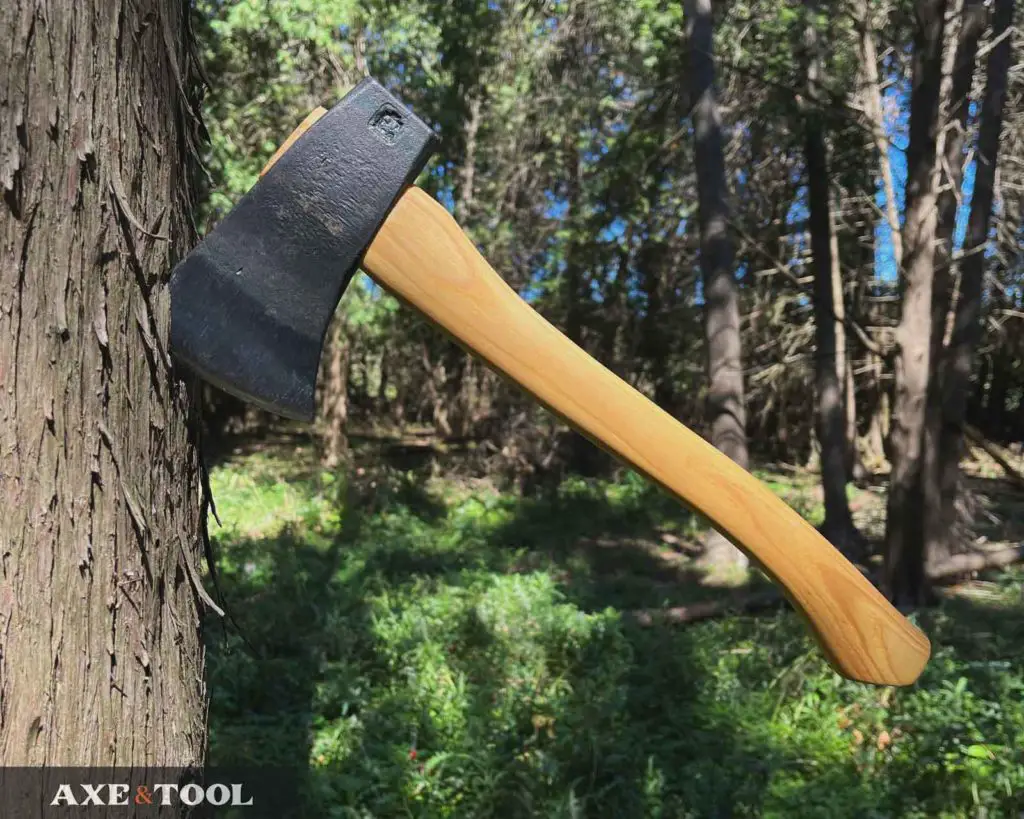
A flat landing is also important for carpenter’s tools, and even normal hatchets where the work is close up and when fine detailing is important. Especially if the back side is to be used as a hammer, you need flat consistent swings.
Most “standard” hatchets have a curve in the grip but are straight(ish) the rest of the way – which can be a very versatile combination.
Straight Handles for Double-Sided Tools
When working with two-sided tools like a double-bit axe, Pulaski, or a maul – a straight handle lets you quickly flip back and forth and use both sides equally. Since these heads are also more equally weighted, a straight handle will balance it better as well.
Curved Handles on Double-bit Axes
There are double-bit axe handles that are curved, known as Adirondack handles. If each blade has a different edge profile, these handles allow the user to know which side is which without looking – and give preference to the primary edge.
They were used in logging in the Adirondack region in the early 1900s (hence the name), and have become quite popular for restorations.
The Curved Handle Debate – Why Dudley Cook was Wrong
Some point to the famous “The Ax Book” by Dudley Cook – as proof that the straight axe handle is superior for all tasks. He describes the curved handle as a marketing gimmick that makes an axe less accurate, and something axe users must overcome.
And while he was a better and more experienced axeman than me – he’s wrong.
Is a Curved Axe Handle Less Accurate?
A curved grip is not less accurate – it’s just different than a straight handle.
Cook argues that the curved grip of an axe changes the pivot point and results in a greater deviation between swings – making a curved axe handle less accurate, and he uses math in his book to “prove” this.
But the pivot point isn’t in the axe at all – the axe does not pivot. The user’s wrist and arm pivot. And as written earlier, the curve aligns the axe with the arm by compensating for the natural angle of the wrist.
Cook only looked at the axe itself and failed to account for the form and function of the human body – which is a pretty important piece of how an axe works.
Curved Handles Were More Than Just Marketing
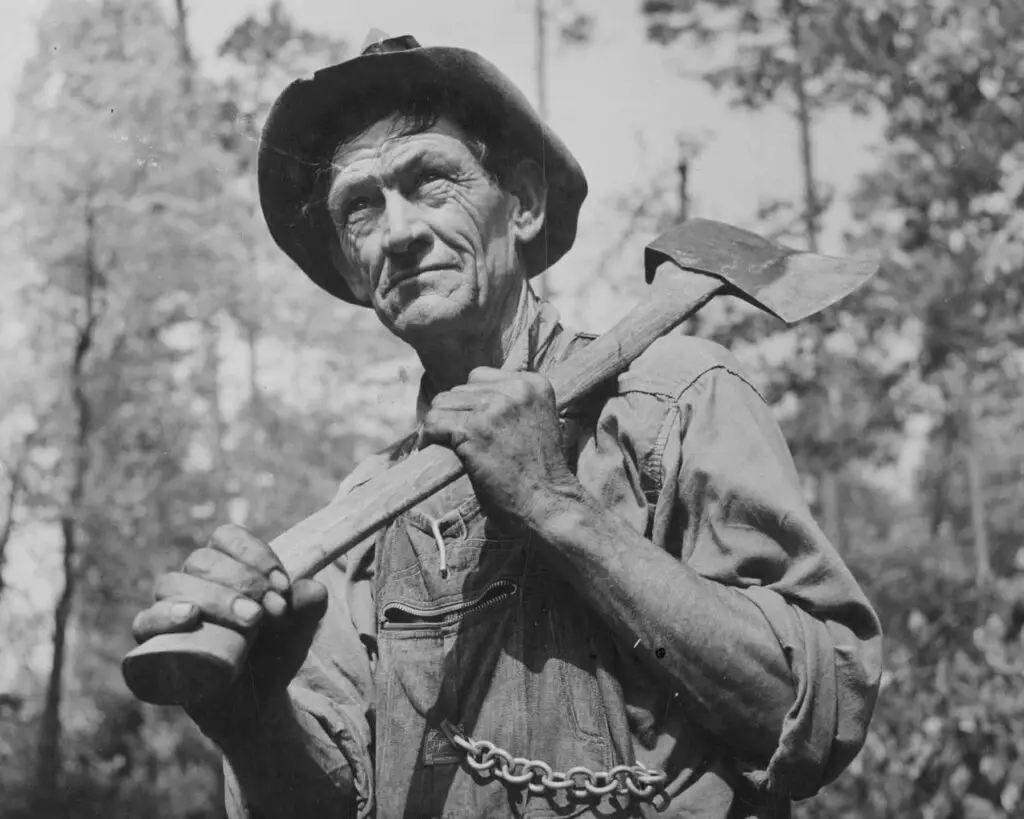
The other big issue I have with “The Ax Book”, is the premise the curved handle was nothing more than a marketing gimmick that stuck.
The idea that the entire axe industry focused on an inferior handle, that was harder to make, for over 100 YEARS, including the peak of axe use and production (with tens of millions made per year), because of a single gimmick – is insane.
Cook mentions that many lumbermen preferred the straight handle – and for some that was likely true, especially on the west coast where they were accustomed to double-bits. That is supported by the fact that some companies offered a “Lumberman” handle pattern that was mostly straight.
But, giant swaths of North America to the east were logged with single-bit axes; Michigans, Kentuckys, and Daytons all typically on curved handles.
Plus let’s not forget the Adirondacks.
The Introduction of the Curved Axe Handle (North America)
Early axes (including early American axes) had straight handles. However, curved handles are far from a modern invention.
Curved handles started to be used in the early 1800s (around 1840) as the lumber industry evolved to tackle the large trees and forests of North America. Heavier axes and heavier work changed the nature of what was needed from an axe.
The booming lumber industry and expanding population were always moving into areas with untouched forests, requiring millions of axes a year.
It’s still unclear exactly when or where the curved handle was developed, but artwork from the 1850s clearly shows an axe with a curved handle that looks very much like an axe handle today.
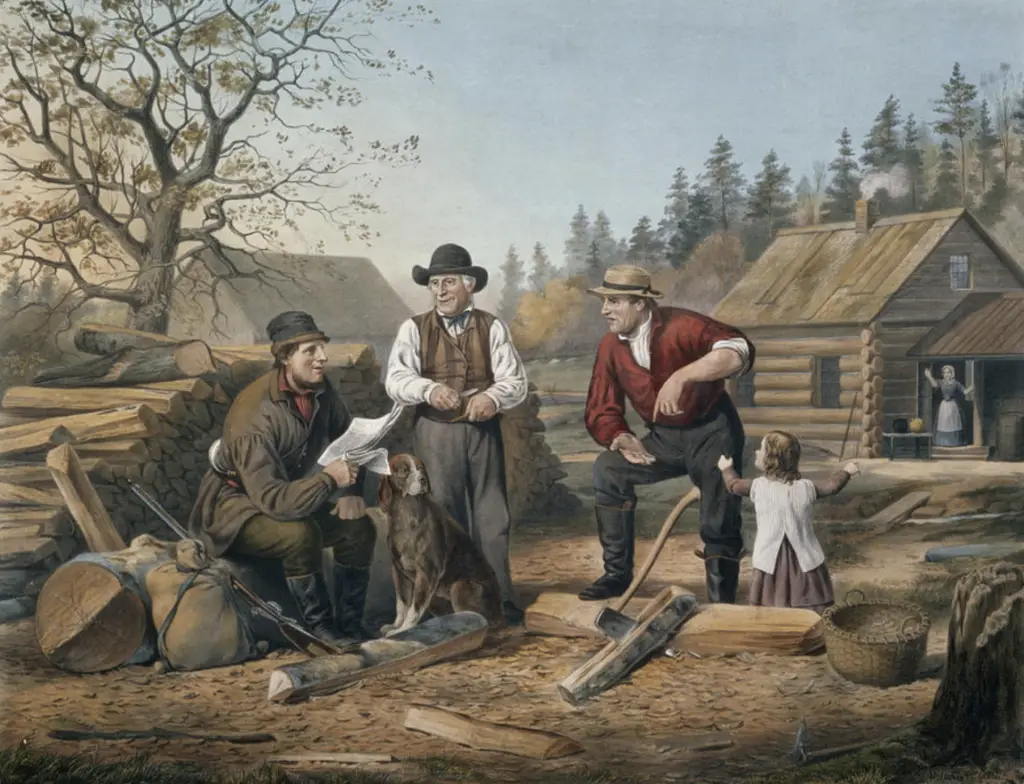
The fact that a curved handle accurately made it into a painting as a commonplace item at this time suggests they had likely been around for a while.
An early advert from 1864 is the first known example (at least to me), showing a modern curved handle. Being that there is no mention of the handle also suggests they were not a new development or worth noting.
Straight handles have always been offered as well, but have always been secondary to the curved handle in any trade magazine or catalog.
Please comment below If I missed something or if you have any questions. I do my best to respond to everyone.
About the author:
About the author:
Jim Bell | Site Creator
I’m just a guy who likes axes. I got tired of only finding crap websites, so I set out to build a better one myself.
I’m also on Instagram: @axeandtool
Sources
- US Forest Service
- Turner Day Catalog 1926
- The Axe Book – Dudley Cook
- Smithsonian American Art Museum


Really great, informative article that’s got me interested in digging deeper into the history. Many thanks! 🙏
Appreciate it!
I like the curved handle hatchet because, as you point out, the handle end can be grabbed like a handshake and keep the forearm aligned.
The problem with curved handle axes, however, is the top hand never aligns properly resulting in a massive loss of power.
“like a handshake” is a great way put it.
However, as for a loss of power – that is just an internet myth in my experience. Your wrists aren’t where the power comes from. In fact because of the limited rotation of your bottom wrist, a straight handled swing would technically be shorter and potentially less powerful. The curve lets your top hand travel further comfortably. So it’s more about how you align your body with the target.
Thats also why competitive racing axes come with curved handles. That’s a sport where power is critical.
But at the end of the day, unless you are in a competition you shouldn’t be max-strength swinging anyway. So it really doesn’t matter beyond personal preference. Thanks for the comment.
Great post. I like to carve handles and for inspiration I was looking up some old photos of chopping axes from heyday of logging in the Ottawa Valley. Every single one has a long, thin, curved handle. Recently got an eyerolling lecture from a credulous Dudley Cooke apostle so I’ve been freshly annoyed at that and this was good antidote.
Ha, thanks so much for the comment. You can probably tell, but that topic always annoyed me too. Cooke’s arguments make sense at first glance, and I bought it initially too. But the more experience I got, the less it made sense. It took me a while to figure out and articulate why. So I’m really glad it made sense to you, lol.
Although, I don’t think we will be able to convince everyone (and in the end it doesn’t really matter).